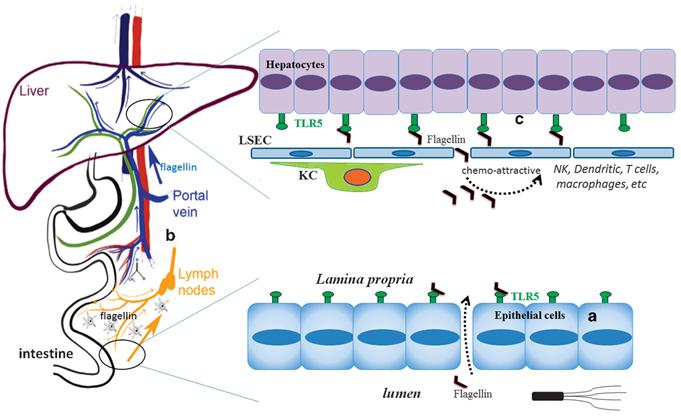
Our promise to you:
Guaranteed product quality, expert customer support.
 24x7 CUSTOMER SERVICE
24x7 CUSTOMER SERVICE
 CONTACT US TO ORDER
CONTACT US TO ORDER
TLR5 Gene Editing 
Toll-like receptors (TLRs) play a key role in innate immunity through stimulating the first line of defense against invading pathogens. TLRs are membrane-bound antigen recognition receptors, which can directly recognize highly conserved molecular structures in pathogens by their horseshoe-shaped, leucine-rich repeat (LRR) ectodomains. Each TLR recognizes different sets or subsets of antigens with different ligand binding mechanisms. TLR5 is the only conserved protein-binding TLR in vertebrates from fish to mammals. TLR5 responds to a monomeric form of flagellin from β- and γ-proteobacteria, which constitutes the whiplike flagellar filament responsible for locomotion. Flagellin (hereafter termed FliC) binding to TLR5 induces MyD88-dependent signaling and activates the proinflammatory transcription factor NF-kB in monocytes, epithelial cells, and dendritic cells, thereby activating the innate immune responses against flagellated bacteria. As flagellin functions as an activator for the first line of defense against flagellated pathogenic bacteria, flagellin has been used to develop a vaccine carrier protein or a vaccine adjuvant. Fusion proteins of flagellin with an antigen have been proven to be effective as experimental vaccines against a variety of infectious diseases, including influenza, malaria, plague, West Nile fever, and tuberculosis. Flagellin-activated TLR5 can also protect hematopoietic cells and the gastrointestinal tissue from radiation and was reported to affect cancer cell survival and growth.
 Figure 1. TLR5 is in the intestine and liver for the recognition of flagellin and other substances. (Yang J, Yan H. 2017)
Figure 1. TLR5 is in the intestine and liver for the recognition of flagellin and other substances. (Yang J, Yan H. 2017)
TLR5 is expressed constitutively in immune cells and epithelial cells, such as monocytes and immature DCs. TLR5 is preferentially expressed on the apical side of respiratory epithelia in mice and humans. Therefore, TLR5 can induce early signaling dedicated to protective innate immune responses against respiratory infection. The expression profile and subcellular distribution features of TLR5 in the gastrointestinal tract are consistent with the prominent location of bacteria in the gastrointestinal tract and the requirements of the gut immune system to address gastrointestinal microbiota, in which commensal dissemination to extraintestinal organs, the overgrowth of toxigenic members or opportunistic pathogenic bacterial invasion and infection need to be constantly monitored and prevented. Accordingly, TLR5 is used by the mucosal immune system of the gut to detect flagellin for the surveillance of gastrointestinal microbiota. Therefore, intestinal epithelial cell TLR5 senses the composition and localization of the intestinal microbiota to prevent diseases related to intestinal inflammation. Another study showed that the liver is the major organ that responds to the TLR5 agonist. In addition, hepatocytes were found to be the key liver cell type that responds rapidly and directly to a flagellin analog but not to LPS, and the activation of liver TLR5 has been proved to play a central role in flagellin's radioprotective and anticancer properties.
In addition to the roles of TLR5 in the respiratory tract, gastrointestinal tract and liver, a recent study on mechanical allodynia in neuropathic pain showed that the effect of TLR5 activation in neurons even works beyond its recognition of flagellin. This study found that TLR5 is expressed by peripheral sensory neurons, in which TLR5 mediates touch sensation and allows the rapid transport of certain small molecules across the neuronal membrane by an unknown mechanism. This introduces a promising new therapeutic strategy to treat persistent pain by targeting TLR5. In addition, some studies suggested that TLR5 downregulation prompted triple-negative breast cancer (TNBC) proliferation, metastasis, and invasion, in vitro and in vivo. More importantly, researchers found that TLR5 on TNBC could potentially serve as a reporter for lower invasion, lower metastasis, and better prognosis. These results provide a novel target molecule for earlier TNBC detection and prognosis prediction, and this could provide the means for new strategies for monitoring and predicting TLR5-positive tumors.
TLR5 Gene Editing Services
CRISPR/Cas9 PlatformCB, one of the leading biotechnological companies specializing in gene editing, is dedicated to offering comprehensive CRISPR/Cas9 gene-editing services to a wide range of genomics researchers. Based on our platform, we can help you effectively TLR5 gene deleted, inserted or point mutated in cells or animals by CRISPR/Cas9 technology.
- TLR5 Gene Knockout: We offer TLR5 gene knockout cell line and knockout animal model generation service with high quality. Typically, we develop CRISPR-mediated gene editing cell lines including HEK239T, Hela, HepG2, U87, but we can use other cell lines according to your requirements. Our one-stop KO animal model generation service covers from sgRNA design and construction, pronuclear microinjection to Founders genotyping and breeding.
- TLR5 Gene Knockin: CRISPR/Cas9 PlatformCB provides the one-stop TLR5 knock-in cell line and knockout animal model generation services, including point mutation and gene insertion. Our expert staff has succeeded in dozens of TLR5 knock-in cell line generation projects, including stem cells, tumor cells and even difficult-to-handle cells. We also have extensive experience in incorporating CRISPR/Cas9 technology into animal models, which have been fully recognized by our clients.
If you have any questions, please feel free to contact us.
Related Products at CRISPR/Cas9 PlatformCB
| CATALOG NO. | PRODUCT NAME | PRODUCT TYPE | INQUIRY |
| CDKM-0172 | B6J-Tlr5em1Cflox | Knockout Mouse | Inquiry |
References
- Yoon S, et al. Structural basis of TLR5-flagellin recognition and signaling. Science, 2012, 335(6070): 859-864.
- Song W S, et al. A conserved TLR5 binding and activation hot spot on flagellin. Scientific reports, 2017, 7(1): 1-11.
- Yang J, Yan H. TLR5: beyond the recognition of flagellin. Cellular & molecular immunology, 2017, 14(12): 1017-1019.
- Shi D, et al. TLR5: A prognostic and monitoring indicator for triple-negative breast cancer. Cell death & disease, 2019, 10(12): 1-11.